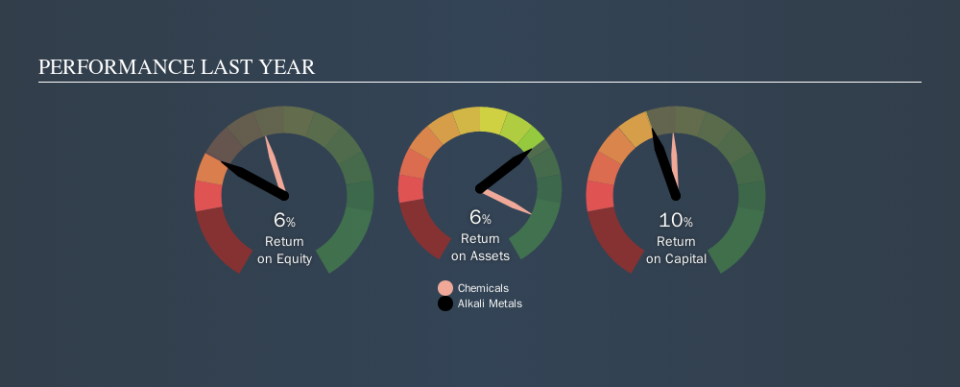Why Alkali Metals Limited’s (NSE:ALKALI) Return On Capital Employed Might Be A Concern

Today we'll evaluate Alkali Metals Limited (NSE:ALKALI) to determine whether it could have potential as an investment idea. Specifically, we'll consider its Return On Capital Employed (ROCE), since that will give us an insight into how efficiently the business can generate profits from the capital it requires.
Firstly, we'll go over how we calculate ROCE. Then we'll compare its ROCE to similar companies. And finally, we'll look at how its current liabilities are impacting its ROCE.
Return On Capital Employed (ROCE): What is it?
ROCE measures the 'return' (pre-tax profit) a company generates from capital employed in its business. All else being equal, a better business will have a higher ROCE. Overall, it is a valuable metric that has its flaws. Author Edwin Whiting says to be careful when comparing the ROCE of different businesses, since 'No two businesses are exactly alike.
So, How Do We Calculate ROCE?
Analysts use this formula to calculate return on capital employed:
Return on Capital Employed = Earnings Before Interest and Tax (EBIT) ÷ (Total Assets - Current Liabilities)
Or for Alkali Metals:
0.097 = ₹53m ÷ (₹910m - ₹363m) (Based on the trailing twelve months to June 2019.)
So, Alkali Metals has an ROCE of 9.7%.
View our latest analysis for Alkali Metals
Does Alkali Metals Have A Good ROCE?
One way to assess ROCE is to compare similar companies. In this analysis, Alkali Metals's ROCE appears meaningfully below the 17% average reported by the Chemicals industry. This performance could be negative if sustained, as it suggests the business may underperform its industry. Putting aside Alkali Metals's performance relative to its industry, its ROCE in absolute terms is poor - considering the risk of owning stocks compared to government bonds. It is likely that there are more attractive prospects out there.
You can click on the image below to see (in greater detail) how Alkali Metals's past growth compares to other companies.
It is important to remember that ROCE shows past performance, and is not necessarily predictive. ROCE can be misleading for companies in cyclical industries, with returns looking impressive during the boom times, but very weak during the busts. ROCE is, after all, simply a snap shot of a single year. If Alkali Metals is cyclical, it could make sense to check out this free graph of past earnings, revenue and cash flow.
Do Alkali Metals's Current Liabilities Skew Its ROCE?
Current liabilities are short term bills and invoices that need to be paid in 12 months or less. Due to the way ROCE is calculated, a high level of current liabilities makes a company look as though it has less capital employed, and thus can (sometimes unfairly) boost the ROCE. To counter this, investors can check if a company has high current liabilities relative to total assets.
Alkali Metals has total liabilities of ₹363m and total assets of ₹910m. Therefore its current liabilities are equivalent to approximately 40% of its total assets. Alkali Metals has a medium level of current liabilities (boosting the ROCE somewhat), and a low ROCE.
What We Can Learn From Alkali Metals's ROCE
This company may not be the most attractive investment prospect. But note: make sure you look for a great company, not just the first idea you come across. So take a peek at this free list of interesting companies with strong recent earnings growth (and a P/E ratio below 20).
I will like Alkali Metals better if I see some big insider buys. While we wait, check out this free list of growing companies with considerable, recent, insider buying.
We aim to bring you long-term focused research analysis driven by fundamental data. Note that our analysis may not factor in the latest price-sensitive company announcements or qualitative material.
If you spot an error that warrants correction, please contact the editor at editorial-team@simplywallst.com. This article by Simply Wall St is general in nature. It does not constitute a recommendation to buy or sell any stock, and does not take account of your objectives, or your financial situation. Simply Wall St has no position in the stocks mentioned. Thank you for reading.

